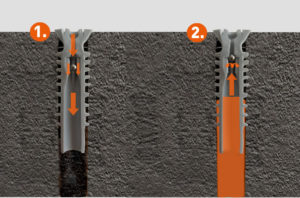As Termite Awareness Week has just ended and with swarming season on the horizon, all this chatter about termites may have you wanting to know more about these troublesome critters and how they destroy your home. Like anything else, it’s important to treat the root of the problem before it gets out of hand and if possible, to save yourself from costly damages. If you’ve never had a termite infestation before, you may not know what to look for or where especially since these tiny home invaders do their damage from the inside out. To help you out, we’ve put together some of the most frequently asked questions about termites to help you identify if you have a termite infestation in your home.
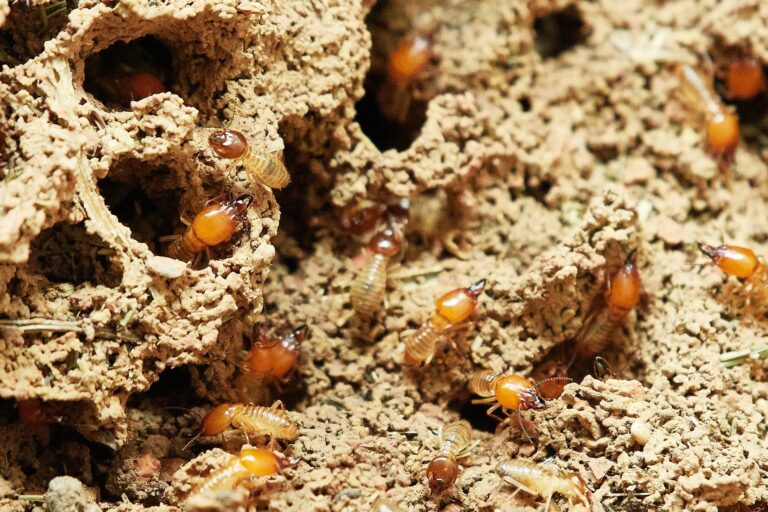
How many different types of termites exist?
Out of the thousands of different termite species found worldwide, there are approximately 45 different species found here in the US. Each of these species can be organized into one of three main termite types: Subterranean, Drywood, and Dampwood, although the Eastern subterranean is the most common in the US.
As you can imagine, each species has its unique characteristics and behaviors that determine where they can be found, where they nest, and the level of damage they are capable of causing your home.
What do termites look like?
Most termites range from a creamy white to a light brown or brown color with long narrow bodies, and straight antennae, and are typically between ¼ and ½ inches long. However, because termites are social insects that live in colonies, they organize themselves into a caste system that includes three major roles and therefore three different sets of physical attributes.
Worker termites are pale or creamy white and tend to be a bit smaller than the colony’s king and queen. Soldier termites can have white or opaque bodies but have darker heads and a distinct large mandible used for defending the colony. Reproductive or swarming termites are more noticeable as they tend to be darker in color (except for Formosan termites who are a pale to yellow-tinted brown color) and are the only termites to possess a set of wings.
It is important to note that reproductive termites are often mistaken for carpenter ants. Here are the main differences to look out for if you happen to see them in your home: Reproductive termites have straight antennae, a broad waist, and two sets of wings equal in length that they shed when they find a new place to start their new colony. Carpenter ants have bent antennae, a more defined (narrow) waist, and two sets of wings that are different in length.
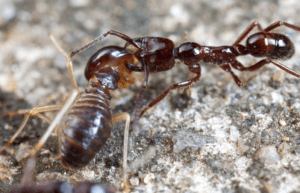
what do termites eat and can they eat through concrete?
You’ve most likely heard or read that termites eat wood, and while this is true, what they are actually after is the cellulose and nutrients found inside. Cellulose, an organic compound, can be found in wood as well as many other materials such as leaves, drywall, paper, cardboard, and cloth.
As for concrete, no, they are not quite powerful enough to eat through concrete. However, after the concrete has been poured and settled, cracks inevitably form which leaves it vulnerable to termite infestations. Termites only need a tiny crack in the foundation to grant themselves access to what they want: your wood structures.
Do termites bite and are they dangerous to humans?
Simply put, no, termites do not bite humans. However, soldier termites do possess large mandibles that are used to protect the colony and could accidentally pinch or bite human skin, although this is very rare. Since termites have poor vision, this is never done on purpose as termites are herbivores, meaning they eat plant-based matter.
As for other potential dangers, it is important to note that while they do not carry diseases harmful to humans, they may cause a flare-up in allergies or asthma attacks. This is due to the spreading of dust particles from termite nests through central air systems as well as a disruption of the mold and mildew as termites eat through the wood.
If you experience a termite infestation you don’t need to be too worried about your health, however, you can worry about your safety inside your home. The intense structural damage termites can cause can lead to dangerous consequences if left untreated, which is why we recommend you contact a termite control professional as soon as termites are detected in your home.
What is swarming season and why do termites lose their wings?
Because the sole purpose of termite swarms is for the reproduction and expansion of the colony, swarming season occurs once the original colony reaches maximum capacity and needs to expand. As you read before, different termite species have different behaviors including their swarming seasons.
For example, most subterranean termite species swarm in the spring and summer months when the temperatures start to warm up and the weather is humid after rainfall. Drywood termites, on the other hand, tend to swarm during the late summer or early fall months, around August to November. While dampwood termites can swarm throughout the year, you are most likely to experience this in the late summer, from August to October.
Although swarming season means that alates (reproductive termites) leave their nest to mate and create new colonies, they do not always move far from the original nest. The goal is to stay close to an established food source (your home) so they may move only a few hundred feet.
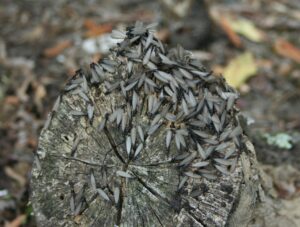
After leaving the nest, the termite alates will then shed their wings and pair off to start new colonies. Although many are not successful (dying due to dehydration or attack by predators), those who are will immediately search for a new location to build their nest and begin growing the new colony.
It is possible to find these shed wings around your home near closed windows and doors.
where are termites found in the us?
Termites can be found in every state except Alaska, although some cities are more at risk than others, with Florida having the highest risk of termite damage. Due to their attraction to warmer climates, termites are most active in the South, Southeast, West, and Southwest. In the US, Formosan subterranean termites are the biggest threat and can cause the most damage. However, depending on the climate conditions of your region, you may be susceptible to different types of termites.
can i do anything to prevent a termite infestation?
Yes. Since termites become an issue once they have access to wood (cellulose) and similar materials, there are several precautions you can take to minimize the risk of termites. Here are a few easy things you can do to help protect your home.
Any sort of firewood, lumber and even spare cardboard should be stored away from the house. Storing these materials too close to your home or in crawl spaces may attract termites and create a safe passage for them into your home.
You should regularly check your gutters, downspouts, and any sources of water that could create excess moisture around your foundation. Clogged gutters with leaf debris cause water to back up and leaf decay, and leaky or misdirected downspouts can create pools of moisture. Both of these issues create ideal conditions for a termite infestation.
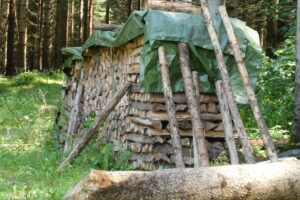
Similarly, making sure that enclosed, windowless areas in your home are properly ventilated can also help deter termites. Without proper ventilation, spaces like basements or attics can easily become the perfect habitat for termites as condensation build-up can lead to mildew and rot, both attracting termites.
And of course, we recommend scheduling routine treatments and inspections with your local pest management company as they will be able to help you implement a preventative treatment plan and tell you if your home is being infested.
How to spot termite damage?
Since termites work their way from the inside out, the damage they cause is not always visible to the untrained eye. For starters, termite-infested wood may sound hollow when tapped or knocked on, although this isn’t something you can know by simply looking at it. However, there are a few signs you can be on the lookout for just in case.
As mentioned before you may find discarded wings inside your home around windows, door frames, or even on the floor. This occurs during swarming season (the warmer months) when reproductive termites leave the nest to start new colonies, shedding their wings once a new location has been found.
You may also see mud tubes (or galleries) in the basement or along the foundation of the house. Made by subterranean termites, these tunnels connect their colonies underground to their food sources above ground.
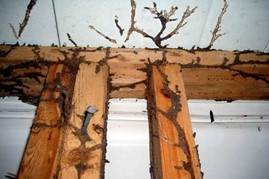
The last easy-to-spot sign is frass, or drywood termite droppings that look like mounds of pellets. Drywood termites tunnel and nest inside of wood, creating galleries that they keep clean by creating kick-out holes, used to remove their excrement. Finding mounds of pellets, usually in shades of brown resembling coffee grounds or sawdust, could mean the presence of drywood termites.
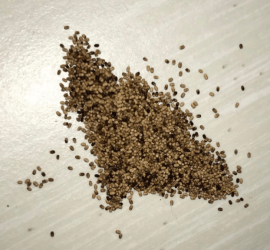
what can i do if I have termites in my home?
First and foremost, we recommend calling your local pest control professional to target the problem and assess the level of damage. Inspection and treatment can be complicated and dangerous so it’s best to leave this task to trained professionals.
Does my home insurance cover termite damage?
More often than not, homeowners insurance companies do not cover termite damage or removal because they generally consider this type of damage to be preventable and therefore the responsibility of the homeowner. To avoid expensive damage and repair costs, we advise you to contact a PCP to inspect your home for termites and damage.
How does the MABI injection system work with my termite treatment?
The innovative MABI injection system makes treating termites easy and mess-free. Our injectors contain a one-way metal ball that leaves the passage free during injection and closes the passage via counter-pressure afterward. This system means there is no product backflow during injection, allowing for a cleaner and safer process for both technicians and homeowners.
More importantly, the MABI system can be used with the injection equipment you or your pest control professional already have. All you need to do is select the appropriate injector size and color, use an injection tip or adapter, and you’re ready to go.
Contact one of our distributors directly to order your MABI injectors.
